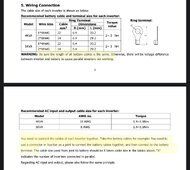Victron Wiring Unlimited. Section 4.9.
"Different voltages mean different currents. The unit with a lower voltage
will have a higher current running through its power electronics. Inverter/
charger overload is triggered by the amount of this current. So, although the
power that each inverter delivers will be the same, the unit with the lower
voltage will have a larger current running through it and will go into overload
before the other units do. The total inverter power of the system will now
be less because when one unit goes into overload, the whole system will
stop working. The unit with bad wiring will determine the performance of the
whole system"
It is all a matter of degree. Everyone would agree that if one inverter had 100 ft more cable than the other it could be a problem.
I think everyone would agree that if one inverter had 1/16 inch more cable it would not matter. I simply assert that the 4' we are talking about does not make enough difference to worry about.



